Abstract
By combining a DNA subclone and synthetic-peptide approach, we mapped epitopes of the immunogenic mycobacterial 70-kDa heat shock protein (HSP70) recognized by human CD4+ T-cell clones and lines. In addition, we identified the respective HLA-DR molecules used in antigen presentation. The donor groups used were healthy persons immunized with killed Mycobacterium leprae and tuberculoid leprosy patients. The results show that the N-terminal part of the HSP70 molecule contains three different T-cell epitopes, of which two were presented by DR7 (amino acids [aa] 66 to 82 and 210 to 226) and one was presented by DR3 (aa 262 to 274). The C-terminal part contains one epitope (aa 413 to 424) presented by HLA-DR2. The C-terminal epitope shows extensive homology to the corresponding region of the human HSP70 sequence. All of the T-cell epitopes identified were presented by only one particular HLA-DR molecule. We also found that HLA-DR5 and DRw53 can present HSP70 to T cells, demonstrating the presence of additional epitopes not yet defined at the peptide level. On the basis of the donors used in this study, recognition of HSP70 at the epitope level seems to be ruled by the restriction elements expressed by the donor rather than by any difference in reactivity between healthy individuals and patients. In conclusion, mycobacterial HSP70 is relevant to subunit vaccine design since it contains a variety of T-cell epitopes presented in the context of multiple HLA-DR molecules.
Full text
PDF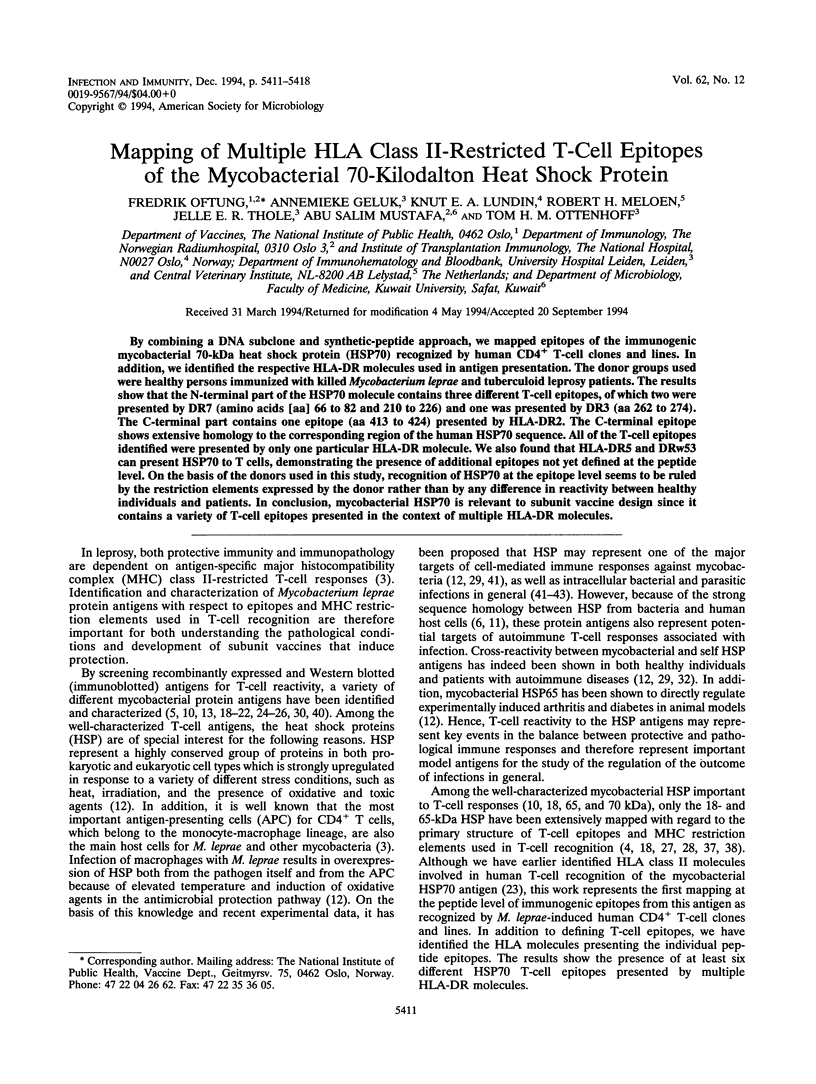
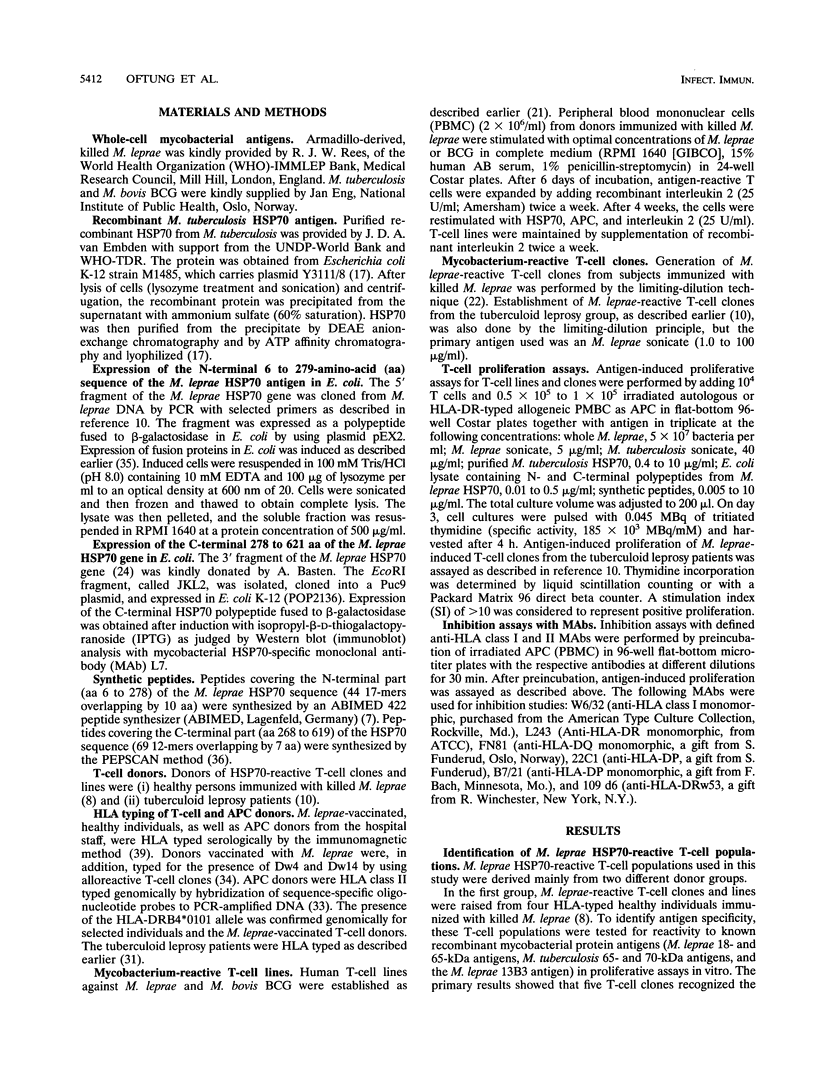
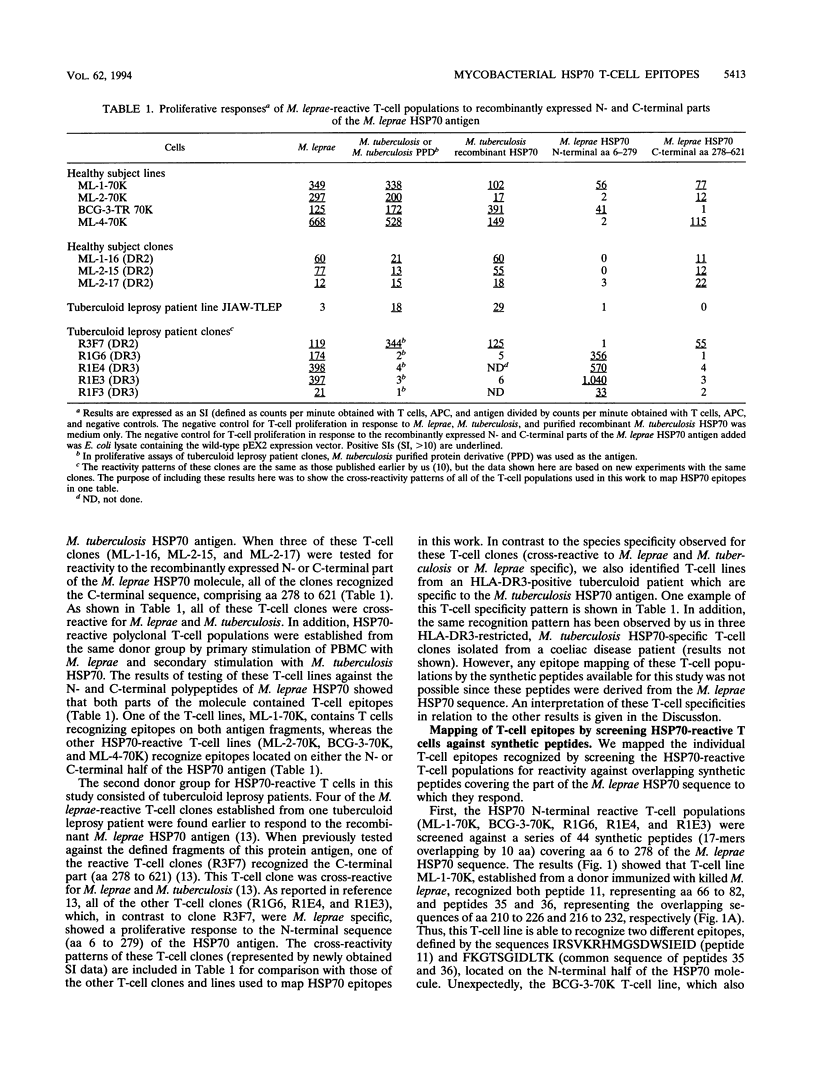
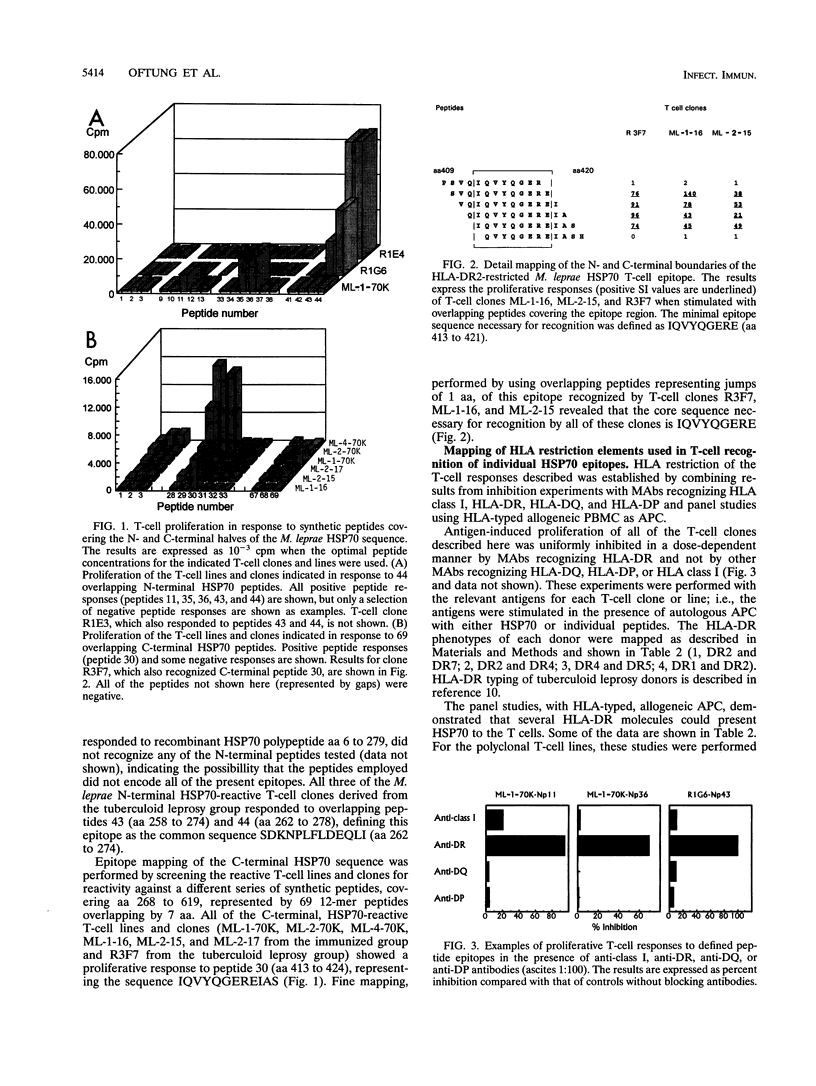
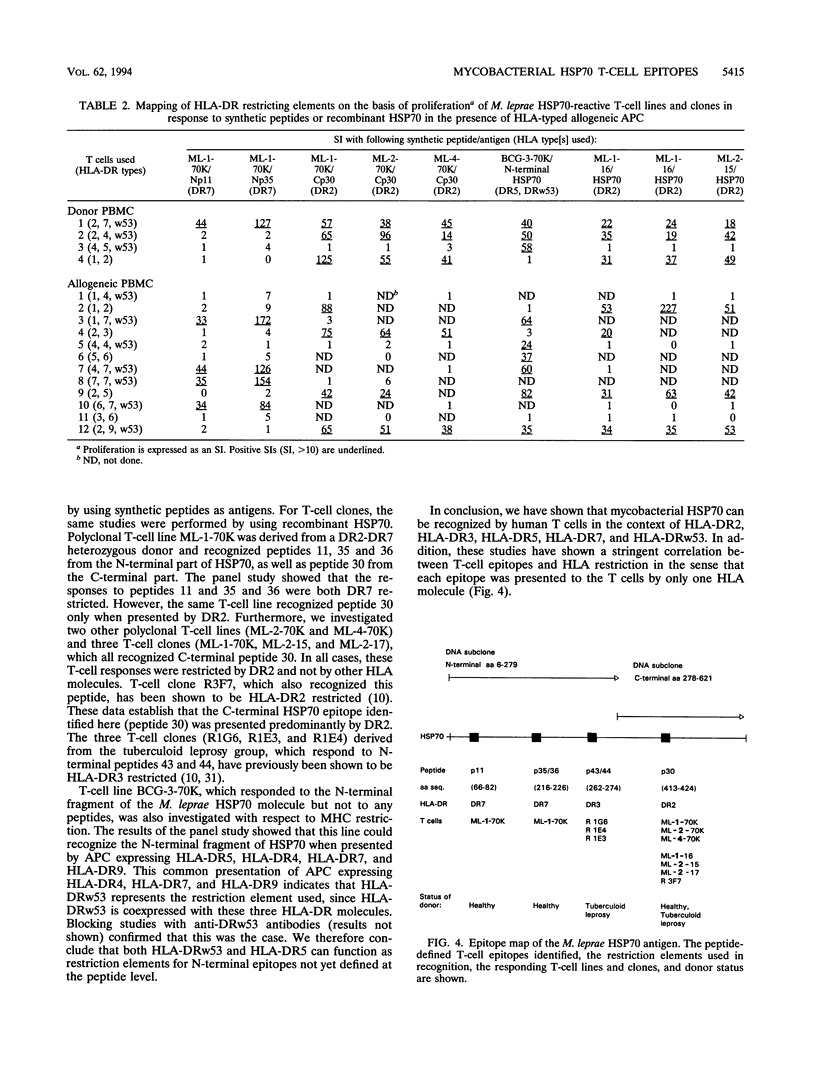
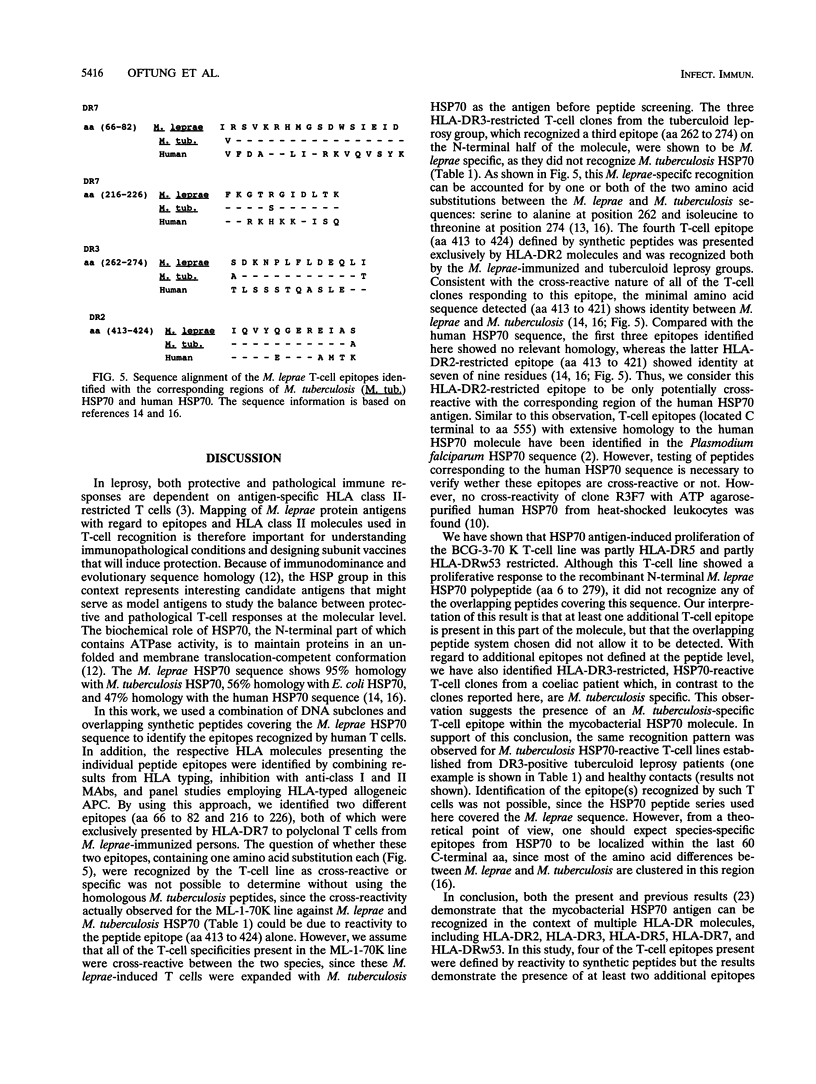
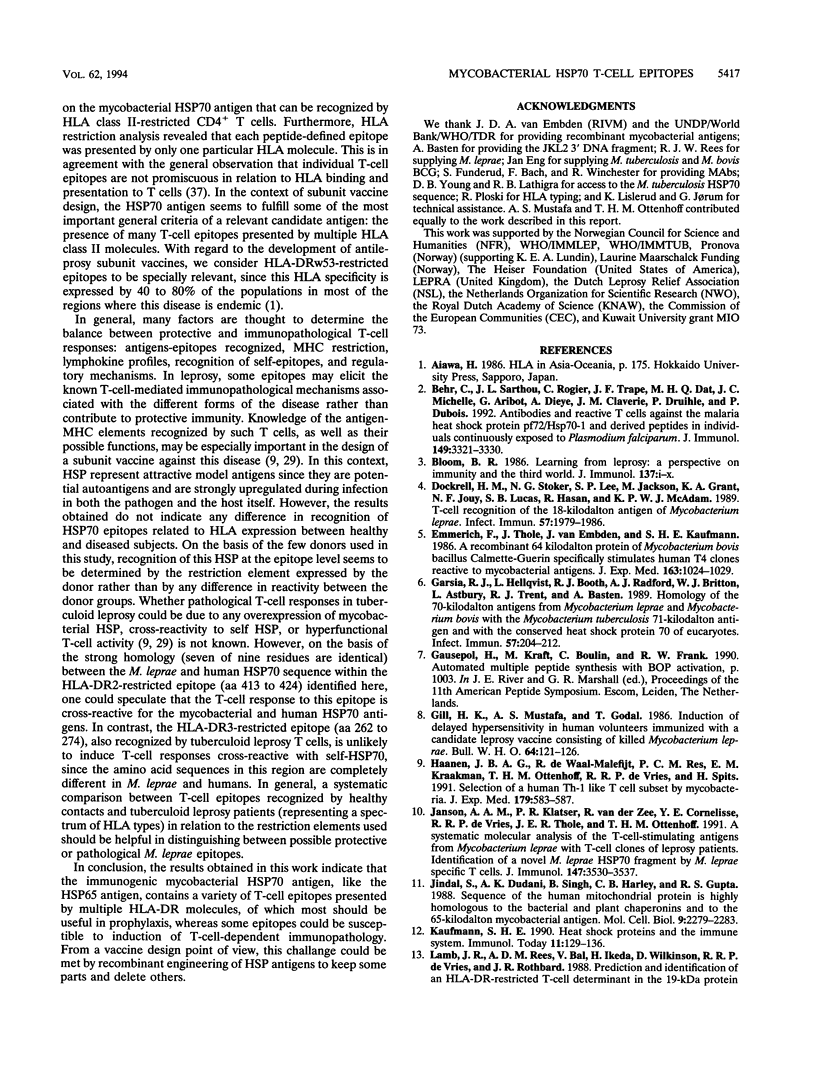
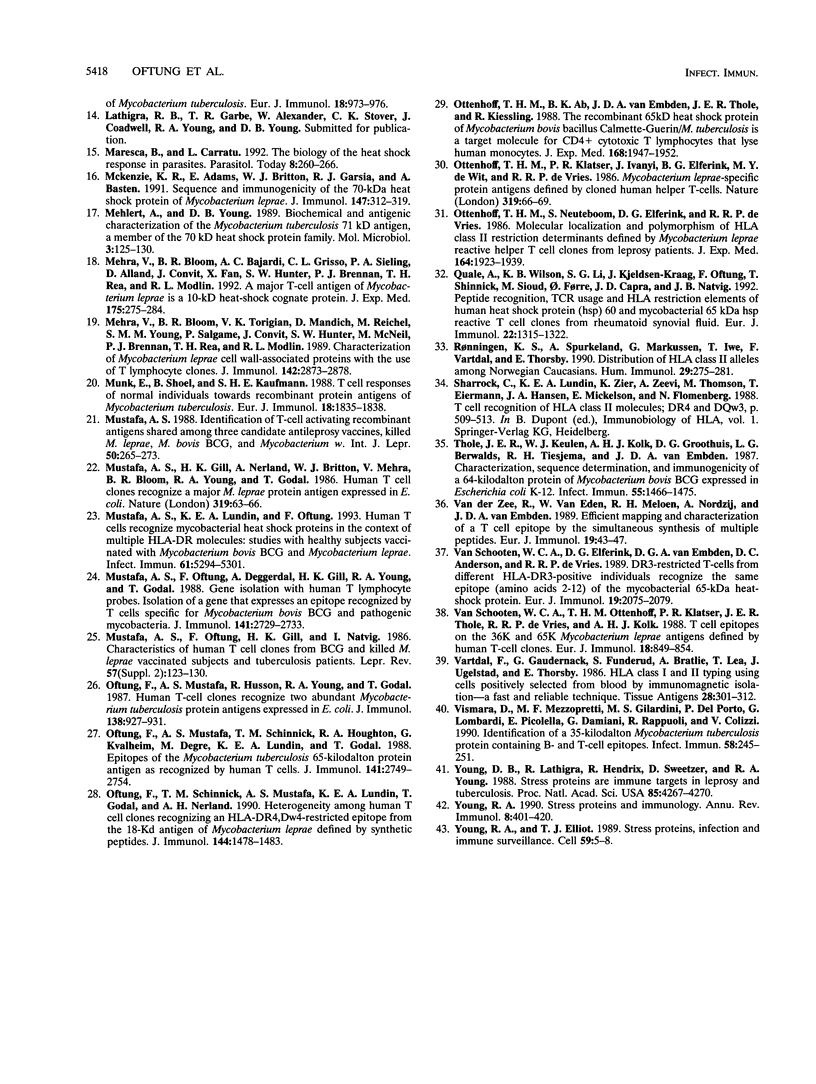
Selected References
These references are in PubMed. This may not be the complete list of references from this article.
- Behr C., Sarthou J. L., Rogier C., Trape J. F., Dat M. H., Michel J. C., Aribot G., Dieye A., Claverie J. M., Druihle P. Antibodies and reactive T cells against the malaria heat-shock protein Pf72/Hsp70-1 and derived peptides in individuals continuously exposed to Plasmodium falciparum. J Immunol. 1992 Nov 15;149(10):3321–3330. [PubMed] [Google Scholar]
- Bloom B. R. Learning from leprosy: a perspective on immunology and the Third World. J Immunol. 1986 Jul 1;137(1):i–x. [PubMed] [Google Scholar]
- Dockrell H. M., Stoker N. G., Lee S. P., Jackson M., Grant K. A., Jouy N. F., Lucas S. B., Hasan R., Hussain R., McAdam K. P. T-cell recognition of the 18-kilodalton antigen of Mycobacterium leprae. Infect Immun. 1989 Jul;57(7):1979–1983. doi: 10.1128/iai.57.7.1979-1983.1989. [DOI] [PMC free article] [PubMed] [Google Scholar]
- Emmrich F., Thole J., van Embden J., Kaufmann S. H. A recombinant 64 kilodalton protein of Mycobacterium bovis bacillus Calmette-Guerin specifically stimulates human T4 clones reactive to mycobacterial antigens. J Exp Med. 1986 Apr 1;163(4):1024–1029. doi: 10.1084/jem.163.4.1024. [DOI] [PMC free article] [PubMed] [Google Scholar]
- Garsia R. J., Hellqvist L., Booth R. J., Radford A. J., Britton W. J., Astbury L., Trent R. J., Basten A. Homology of the 70-kilodalton antigens from Mycobacterium leprae and Mycobacterium bovis with the Mycobacterium tuberculosis 71-kilodalton antigen and with the conserved heat shock protein 70 of eucaryotes. Infect Immun. 1989 Jan;57(1):204–212. doi: 10.1128/iai.57.1.204-212.1989. [DOI] [PMC free article] [PubMed] [Google Scholar]
- Gill H. K., Mustafa A. S., Godal T. Induction of delayed-type hypersensitivity in human volunteers immunized with a candidate leprosy vaccine consisting of killed Mycobacterium leprae. Bull World Health Organ. 1986;64(1):121–126. [PMC free article] [PubMed] [Google Scholar]
- Haanen J. B., de Waal Malefijt R., Res P. C., Kraakman E. M., Ottenhoff T. H., de Vries R. R., Spits H. Selection of a human T helper type 1-like T cell subset by mycobacteria. J Exp Med. 1991 Sep 1;174(3):583–592. doi: 10.1084/jem.174.3.583. [DOI] [PMC free article] [PubMed] [Google Scholar]
- Janson A. A., Klatser P. R., van der Zee R., Cornelisse Y. E., de Vries R. R., Thole J. E., Ottenhoff T. H. A systematic molecular analysis of the T cell-stimulating antigens from Mycobacterium leprae with T cell clones of leprosy patients. Identification of a novel M. leprae HSP 70 fragment by M. leprae-specific T cells. J Immunol. 1991 Nov 15;147(10):3530–3537. [PubMed] [Google Scholar]
- Jindal S., Dudani A. K., Singh B., Harley C. B., Gupta R. S. Primary structure of a human mitochondrial protein homologous to the bacterial and plant chaperonins and to the 65-kilodalton mycobacterial antigen. Mol Cell Biol. 1989 May;9(5):2279–2283. doi: 10.1128/mcb.9.5.2279. [DOI] [PMC free article] [PubMed] [Google Scholar]
- Kaufmann S. H. Heat shock proteins and the immune response. Immunol Today. 1990 Apr;11(4):129–136. doi: 10.1016/0167-5699(90)90050-j. [DOI] [PubMed] [Google Scholar]
- Maresca B., Carratù L. The biology of the heat shock response in parasites. Parasitol Today. 1992 Aug;8(8):260–266. doi: 10.1016/0169-4758(92)90137-q. [DOI] [PubMed] [Google Scholar]
- McKenzie K. R., Adams E., Britton W. J., Garsia R. J., Basten A. Sequence and immunogenicity of the 70-kDa heat shock protein of Mycobacterium leprae. J Immunol. 1991 Jul 1;147(1):312–319. [PubMed] [Google Scholar]
- Mehlert A., Young D. B. Biochemical and antigenic characterization of the Mycobacterium tuberculosis 71kD antigen, a member of the 70kD heat-shock protein family. Mol Microbiol. 1989 Feb;3(2):125–130. doi: 10.1111/j.1365-2958.1989.tb01801.x. [DOI] [PubMed] [Google Scholar]
- Mehra V., Bloom B. R., Bajardi A. C., Grisso C. L., Sieling P. A., Alland D., Convit J., Fan X. D., Hunter S. W., Brennan P. J. A major T cell antigen of Mycobacterium leprae is a 10-kD heat-shock cognate protein. J Exp Med. 1992 Jan 1;175(1):275–284. doi: 10.1084/jem.175.1.275. [DOI] [PMC free article] [PubMed] [Google Scholar]
- Mehra V., Bloom B. R., Torigian V. K., Mandich D., Reichel M., Young S. M., Salgame P., Convit J., Hunter S. W., McNeil M. Characterization of Mycobacterium leprae cell wall-associated proteins with the use of T lymphocyte clones. J Immunol. 1989 Apr 15;142(8):2873–2878. [PubMed] [Google Scholar]
- Munk M. E., Schoel B., Kaufmann S. H. T cell responses of normal individuals towards recombinant protein antigens of Mycobacterium tuberculosis. Eur J Immunol. 1988 Nov;18(11):1835–1838. doi: 10.1002/eji.1830181128. [DOI] [PubMed] [Google Scholar]
- Mustafa A. S., Gill H. K., Nerland A., Britton W. J., Mehra V., Bloom B. R., Young R. A., Godal T. Human T-cell clones recognize a major M. leprae protein antigen expressed in E. coli. Nature. 1986 Jan 2;319(6048):63–66. doi: 10.1038/319063a0. [DOI] [PubMed] [Google Scholar]
- Mustafa A. S. Identification of T-cell-activating recombinant antigens shared among three candidate antileprosy vaccines, killed M. leprae, M. bovis BCG, and mycobacterium w. Int J Lepr Other Mycobact Dis. 1988 Jun;56(2):265–273. [PubMed] [Google Scholar]
- Mustafa A. S., Lundin K. E., Oftung F. Human T cells recognize mycobacterial heat shock proteins in the context of multiple HLA-DR molecules: studies with healthy subjects vaccinated with Mycobacterium bovis BCG and Mycobacterium leprae. Infect Immun. 1993 Dec;61(12):5294–5301. doi: 10.1128/iai.61.12.5294-5301.1993. [DOI] [PMC free article] [PubMed] [Google Scholar]
- Mustafa A. S., Oftung F., Deggerdal A., Gill H. K., Young R. A., Godal T. Gene isolation with human T lymphocyte probes. Isolation of a gene that expresses an epitope recognized by T cells specific for Mycobacterium bovis BCG and pathogenic mycobacteria. J Immunol. 1988 Oct 15;141(8):2729–2733. [PubMed] [Google Scholar]
- Mustafa A. S., Oftung F., Gill H. K., Natvig I. Characteristics of human T-cell clones from BCG and killed M. leprae vaccinated subjects and tuberculosis patients. Recognition of recombinant mycobacterial antigens. Lepr Rev. 1986 Dec;57 (Suppl 2):123–130. [PubMed] [Google Scholar]
- Oftung F., Mustafa A. S., Husson R., Young R. A., Godal T. Human T cell clones recognize two abundant Mycobacterium tuberculosis protein antigens expressed in Escherichia coli. J Immunol. 1987 Feb 1;138(3):927–931. [PubMed] [Google Scholar]
- Oftung F., Mustafa A. S., Shinnick T. M., Houghten R. A., Kvalheim G., Degre M., Lundin K. E., Godal T. Epitopes of the Mycobacterium tuberculosis 65-kilodalton protein antigen as recognized by human T cells. J Immunol. 1988 Oct 15;141(8):2749–2754. [PubMed] [Google Scholar]
- Oftung F., Shinnick T. M., Mustafa A. S., Lundin K. E., Godal T., Nerland A. H. Heterogeneity among human T cell clones recognizing an HLA-DR4,Dw4-restricted epitope from the 18-kDa antigen of Mycobacterium leprae defined by synthetic peptides. J Immunol. 1990 Feb 15;144(4):1478–1483. [PubMed] [Google Scholar]
- Ottenhoff T. H., Ab B. K., Van Embden J. D., Thole J. E., Kiessling R. The recombinant 65-kD heat shock protein of Mycobacterium bovis Bacillus Calmette-Guerin/M. tuberculosis is a target molecule for CD4+ cytotoxic T lymphocytes that lyse human monocytes. J Exp Med. 1988 Nov 1;168(5):1947–1952. doi: 10.1084/jem.168.5.1947. [DOI] [PMC free article] [PubMed] [Google Scholar]
- Ottenhoff T. H., Klatser P. R., Ivanyi J., Elferink D. G., de Wit M. Y., de Vries R. R. Mycobacterium leprae-specific protein antigens defined by cloned human helper T cells. Nature. 1986 Jan 2;319(6048):66–68. doi: 10.1038/319066a0. [DOI] [PubMed] [Google Scholar]
- Ottenhoff T. H., Neuteboom S., Elferink D. G., de Vries R. R. Molecular localization and polymorphism of HLA class II restriction determinants defined by Mycobacterium leprae-reactive helper T cell clones from leprosy patients. J Exp Med. 1986 Dec 1;164(6):1923–1939. doi: 10.1084/jem.164.6.1923. [DOI] [PMC free article] [PubMed] [Google Scholar]
- Quayle A. J., Wilson K. B., Li S. G., Kjeldsen-Kragh J., Oftung F., Shinnick T., Sioud M., Førre O., Capra J. D., Natvig J. B. Peptide recognition, T cell receptor usage and HLA restriction elements of human heat-shock protein (hsp) 60 and mycobacterial 65-kDa hsp-reactive T cell clones from rheumatoid synovial fluid. Eur J Immunol. 1992 May;22(5):1315–1322. doi: 10.1002/eji.1830220529. [DOI] [PubMed] [Google Scholar]
- Rønningen K. S., Spurkland A., Markussen G., Iwe T., Vartdal F., Thorsby E. Distribution of HLA class II alleles among Norwegian Caucasians. Hum Immunol. 1990 Dec;29(4):275–281. doi: 10.1016/0198-8859(90)90041-m. [DOI] [PubMed] [Google Scholar]
- Thole J. E., Keulen W. J., De Bruyn J., Kolk A. H., Groothuis D. G., Berwald L. G., Tiesjema R. H., van Embden J. D. Characterization, sequence determination, and immunogenicity of a 64-kilodalton protein of Mycobacterium bovis BCG expressed in escherichia coli K-12. Infect Immun. 1987 Jun;55(6):1466–1475. doi: 10.1128/iai.55.6.1466-1475.1987. [DOI] [PMC free article] [PubMed] [Google Scholar]
- Van Schooten W. C., Elferink D. G., Van Embden J., Anderson D. C., De Vries R. R. DR3-restricted T cells from different HLA-DR3-positive individuals recognize the same peptide (amino acids 2-12) of the mycobacterial 65-kDa heat-shock protein. Eur J Immunol. 1989 Nov;19(11):2075–2079. doi: 10.1002/eji.1830191116. [DOI] [PubMed] [Google Scholar]
- Van Schooten W. C., Ottenhoff T. H., Klatser P. R., Thole J., De Vries R. R., Kolk A. H. T cell epitopes on the 36K and 65K Mycobacterium leprae antigens defined by human T cell clones. Eur J Immunol. 1988 Jun;18(6):849–854. doi: 10.1002/eji.1830180604. [DOI] [PubMed] [Google Scholar]
- Van der Zee R., Van Eden W., Meloen R. H., Noordzij A., Van Embden J. D. Efficient mapping and characterization of a T cell epitope by the simultaneous synthesis of multiple peptides. Eur J Immunol. 1989 Jan;19(1):43–47. doi: 10.1002/eji.1830190108. [DOI] [PubMed] [Google Scholar]
- Vartdal F., Gaudernack G., Funderud S., Bratlie A., Lea T., Ugelstad J., Thorsby E. HLA class I and II typing using cells positively selected from blood by immunomagnetic isolation--a fast and reliable technique. Tissue Antigens. 1986 Nov;28(5):301–312. doi: 10.1111/j.1399-0039.1986.tb00500.x. [DOI] [PubMed] [Google Scholar]
- Vismara D., Mezzopreti M. F., Gilardini Montani M. S., Gilardini M. S., Del Porto P., Lombardi G., Piccolella E., Damiani G., Rappuoli R., Colizzi V. Identification of a 35-kilodalton Mycobacterium tuberculosis protein containing B- and T-cell epitopes. Infect Immun. 1990 Jan;58(1):245–251. doi: 10.1128/iai.58.1.245-251.1990. [DOI] [PMC free article] [PubMed] [Google Scholar]
- Young D., Lathigra R., Hendrix R., Sweetser D., Young R. A. Stress proteins are immune targets in leprosy and tuberculosis. Proc Natl Acad Sci U S A. 1988 Jun;85(12):4267–4270. doi: 10.1073/pnas.85.12.4267. [DOI] [PMC free article] [PubMed] [Google Scholar]
- Young R. A., Elliott T. J. Stress proteins, infection, and immune surveillance. Cell. 1989 Oct 6;59(1):5–8. doi: 10.1016/0092-8674(89)90861-1. [DOI] [PubMed] [Google Scholar]
- Young R. A. Stress proteins and immunology. Annu Rev Immunol. 1990;8:401–420. doi: 10.1146/annurev.iy.08.040190.002153. [DOI] [PubMed] [Google Scholar]


